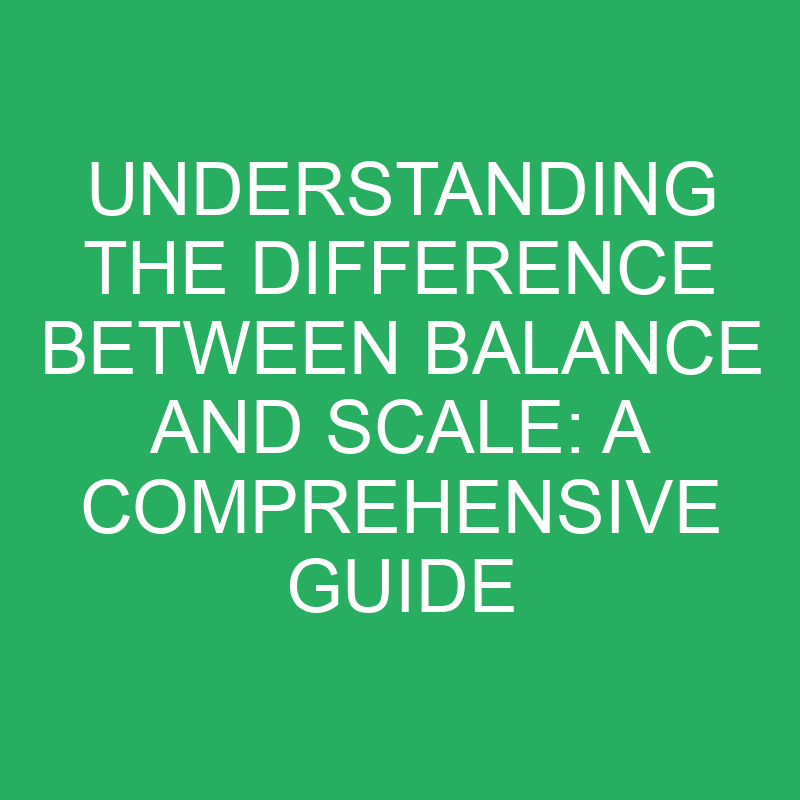
When it comes to measuring weight, two common tools that often get confused are the balance and the scale. While they may seem similar at first glance, there are key differences between the two that can greatly impact their functionality and accuracy. In this article, I’ll break down the fundamental dissimilarities between a balance and a scale, helping you understand which one is best suited for your specific needs. So, if you’ve ever found yourself wondering about the distinction between these two weight-measuring devices, look no further. Let’s dive in and explore the difference between a balance and a scale.
Have you ever wondered why some people use the term “balance” while others prefer the word “scale”? Well, the answer lies in their underlying mechanisms. A balance operates on the principle of comparing two masses, while a scale measures weight by utilizing a force exerted by an object. This fundamental distinction sets the stage for the various characteristics and applications of each device. So, whether you’re a curious learner or a professional in the field, understanding the difference between a balance and a scale is crucial to ensure accurate and reliable weight measurements. Let’s get started and unveil the secrets behind these weight-measuring tools.
Post Contents
Understanding the Terminology
When it comes to measuring weight, it’s important to have a clear understanding of the terminology. Let’s take a closer look at the difference between a balance and a scale, two commonly used terms in weight measurement.
Balance: A balance is a device that compares two masses by equalizing the forces exerted on them. It operates based on the principle of equilibrium, where the weight of an object is balanced against a known reference mass. Balances are commonly used in laboratories and scientific settings where precise measurements are required. They can provide highly accurate results if used correctly.
Scale: On the other hand, a scale measures weight by utilizing the force exerted by an object. It works by measuring the deflection of a spring or the bending of a beam, which is directly proportional to the weight applied. Scales are commonly found in everyday settings such as bathrooms, grocery stores, and households. While they may not be as precise as balances, they are still reliable for most general measurements.
Understanding the distinction between a balance and a scale is vital for obtaining accurate and reliable weight measurements. While the terms are often used interchangeably in everyday conversations, their technical differences should not be overlooked. Using the right device for the intended purpose ensures that you get the most accurate results possible.
In the next section, we will explore the factors that influence the accuracy of weight measurements. Understanding these factors will help you make informed decisions when choosing the right device for your specific needs.
The Mechanism of a Balance
A balance is a device used for comparing the masses of two objects. It operates on the principle of equalizing the forces exerted on the objects being weighed. Let me explain how it works.
- Pivot point: The balance consists of a beam with a fulcrum, or pivot point, in the center. The beam is suspended from this point, allowing it to rotate freely.
- Arms: The beam of the balance has two arms, each with a pan attached at the end. The objects to be weighed are placed on the pans, one on each arm.
- Weights: In order to achieve balance, additional weights can be added or removed on one side of the beam. These weights represent the known mass that is used to compare against the unknown mass.
- Balance point: The balance is adjusted until the beam comes to a rest in a horizontal position. This indicates that the forces exerted on both sides of the beam are equal, signifying that the masses are in equilibrium.
The mechanism of a balance allows for precise and accurate measurements by comparing the masses directly. It is commonly used in laboratories and scientific settings where precise measurements are essential.
The Mechanism of a Scale
When it comes to understanding the differences between a balance and a scale, it’s crucial to delve into the mechanism behind each device. In this section, I’ll explain the inner workings of a scale, shedding light on how it measures weight.
A scale primarily relies on the force exerted by an object to determine its weight. It consists of a platform or surface on which the object is placed. As the object is placed on the platform, the force of gravity acts upon it, causing it to compress or deform certain elements within the scale.
One common type of scale is a spring scale, which utilizes the principle of Hooke’s Law. According to this law, the force required to stretch or compress a spring is directly proportional to the amount of stretch or compression. In a spring scale, a spring is attached to the platform, and as the object is placed on the scale, it compresses the spring. The degree of compression translates into a measurement of weight, which is displayed on a dial or digital screen.
Another type of scale is a strain gauge scale, which employs the use of strain gauges – devices that change their electrical resistance when subjected to mechanical strain. When an object is placed on the platform, the strain gauges deform as the platform bends under the weight, causing changes in resistance. These changes are then converted into weight measurements by the scale’s internal circuitry.
The mechanism of a scale is relatively simple yet effective for everyday weight measurements. They are commonly found in households, retail stores, and other settings where general weight measurements are required. However, it’s important to note that scales are not as precise or accurate as balances, making them unsuitable for scientific or laboratory use.
Key Differences Between a Balance and a Scale
When it comes to measuring weight, it’s essential to understand the differences between a balance and a scale. These two devices serve the same purpose but employ different mechanisms to achieve accurate measurements. Let’s dive into the key distinctions between a balance and a scale.
1. Method of Comparison:
- A balance compares two masses by equalizing the forces exerted on them.
- A scale measures weight by utilizing the force exerted by an object.
2. Precision and Accuracy:
- Balances are known for their precision and accuracy, making them ideal for scientific and laboratory use.
- Scales, on the other hand, are not as precise or accurate, but they are suitable for general measurements in everyday settings.
3. Mechanism:
- Balances consist of a beam with a fulcrum, and two arms with pans attached at the ends.
- Additional weights can be added or removed to achieve balance, with the goal being to have the beam come to a rest in a horizontal position, indicating that the masses are in equilibrium.
- Scales rely on the force exerted by an object to determine its weight.
- There are different types of scales, such as spring scales and strain gauge scales, which measure weight based on the compression or deformation of certain elements within the scale.
It’s crucial to recognize these differences to ensure accurate and reliable weight measurements. While balances provide precise and accurate results required in scientific and laboratory settings, scales are reliable for most general measurements in everyday life.
Factors to Consider When Choosing Between a Balance and a Scale
When it comes to choosing between a balance and a scale for your weighing needs, there are several factors that you should take into consideration. Making the right choice will ensure accurate and reliable weight measurements for your specific requirements. Here are some important factors to consider:
- Precision and Accuracy: Balances are renowned for their high precision and accuracy, making them the preferred choice for scientific and laboratory applications. If you need precise measurements for research or experiments, a balance is the way to go. On the other hand, scales offer sufficient accuracy for general measuring purposes in everyday settings.
- Weight Range: Consider the range of weights you anticipate measuring. Balances can typically handle smaller weight ranges, making them suitable for measuring delicate items or substances in small quantities. Scales, on the other hand, can accommodate a wider range of weights, making them more versatile for measuring both light and heavy objects.
- Portability: If you need to move your weighing equipment frequently or if you require portability, consider the size and weight of the balance or scale. Balances are often more compact and lightweight, making them easier to transport. Scales, on the other hand, vary in size and can be bulkier, so consider your specific needs for portability.
- Ease of Use: Consider how user-friendly the equipment is. Balances typically require calibration and adjustment to ensure accuracy. If you are not familiar with these processes, a scale may be a more straightforward option. Many scales have digital displays and simple controls, making them easy to operate.
- Budget: Last but not least, consider your budget. Balances tend to be more expensive due to their precision and accuracy. Scales, on the other hand, come in a wide range of prices, making them more accessible for various budgets. Determine your budget and weigh it against your weighing needs to make the right choice.
Remember, each weighing instrument has its own advantages and unique features. By considering these factors, you can make an informed decision between a balance and a scale for your specific weighing requirements.
Conclusion
Understanding the differences between a balance and a scale is crucial for accurate weight measurements. Balances are known for their precision and accuracy, making them ideal for scientific and laboratory use. On the other hand, scales are suitable for general measurements in everyday settings.
The mechanism of a balance involves a beam with a fulcrum and two arms with pans attached at the ends. Additional weights can be added or removed to achieve balance. Scales, on the other hand, rely on the force exerted by an object to determine its weight and can be of different types, such as spring scales and strain gauge scales.
When choosing between a balance and a scale, several factors need to be considered. These include precision and accuracy, weight range, portability, ease of use, and budget. By considering these factors, you can make an informed decision that meets your specific weighing requirements.
A balance and a scale have distinct differences in terms of their mechanisms and applications. Understanding these differences and considering the relevant factors will help you choose the right weighing instrument for your needs.
Frequently Asked Questions
Q: What is the difference between a balance and a scale when measuring weight?
A: A balance compares two masses by equalizing the forces exerted on them, while a scale measures weight by utilizing the force exerted by an object.
Q: Which is more accurate and precise, a balance or a scale?
A: Balances are known for their precision and accuracy, making them ideal for scientific and laboratory use, while scales are suitable for general measurements in everyday settings.
Q: How does a balance work?
A: A balance consists of a beam with a fulcrum and two arms with pans attached at the ends. Additional weights can be added or removed to achieve balance.
Q: How does a scale determine weight?
A: Scales rely on the force exerted by an object to determine its weight. There are different types of scales, such as spring scales and strain gauge scales.
Q: What factors should I consider when choosing between a balance and a scale?
A: Factors to consider include precision and accuracy, weight range, portability, ease of use, and budget. Consider these factors to make an informed decision for specific weighing requirements.






